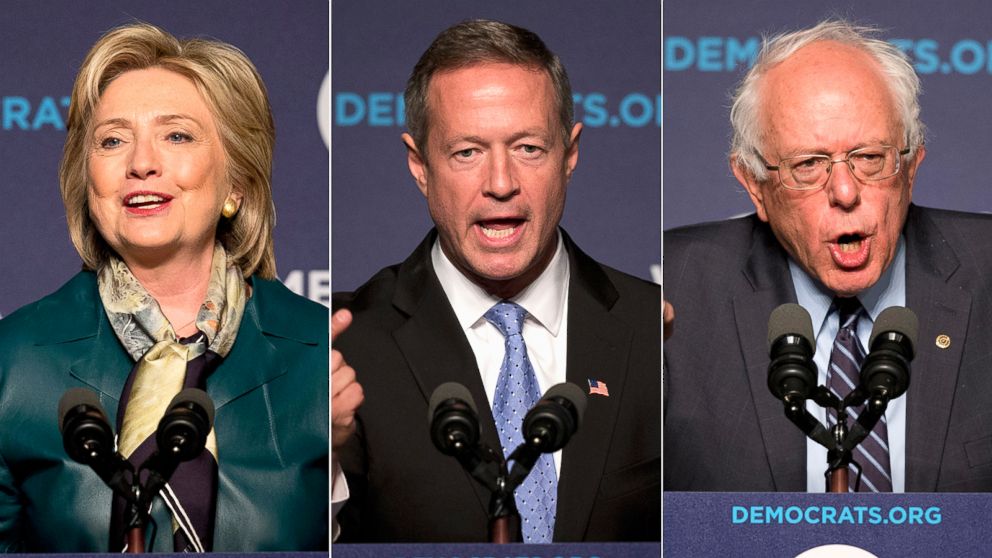Democratic Presidential Candidates: Where They Agree and Disagree on Climate
Ahead of Saturday's ABC News debate, compare candidates' positions on climate.

— -- This month in Paris, the United States along with nearly 200 other countries signed arguably the most sweeping international environmental agreement in history.
Republicans were quick to dismiss it. In stark contrast, all three Democratic presidential candidates argue that climate change is an urgent and serious threat facing the country and demand quick action. Former Maryland Gov. Martin O’Malley and Bernie Sanders, in fact, go so far as to say that the country has a “moral obligation” to curb the effects of toxic greenhouse gases. Sanders even criticized the Paris agreement, saying it “goes nowhere near far enough.”
Michael Brune, Executive Director of the Sierra Club, told ABC News that environmentalists by and large are heartened that the issue of climate change is receiving more attention during this campaign than in the past, but Brune added that grassroots activists are more cautious this time around. They also do not take candidate's campaign speak at face value.
“There was a great euphoria after Barack Obama was elected, but then many felt let down in the first few years,” Brune said. “[Activists] will work hard to get the best candidate elected, but then know they have to continue to work hard after the election.”
While there is an ocean between Democrats and Republicans on the issue, all three Democrats stand united in their call for new investments in renewable energy, such as wind and solar power. But there are also key differences between them.
Here’s a closer look at the three Democratic proposals side by side:
Cutting Carbon Emissions
Where They Agree: Sanders and O’Malley call for tougher federal regulations to limit carbon and other greenhouse gas emissions and increase federal fuel economy standards.
Sanders says he would put a tax on carbon. “A tax on carbon is one of the most straightforward and cost-effective strategies for quickly fighting climate change,” his plan reads.
O’Malley’s plans reads more like a traditional cap-and-trade model. It says he would “fight for federal legislation for a cap on carbon emissions from all sources,” and that “proceeds” (presumably fees paid to companies that violate carbon standards or permits) would go toward conservation programs and job training. The O’Malley campaign did not respond to clarifying questions about this part of his proposal.
Both O’Malley and Sanders call for increasing fuel economy standards for vehicles as well. Sanders says the current federal goals are “lagging” and urges a 65 mpg standard by 2025. O’Malley says he would move the federal government’s vehicle fleet toward zero-emission vehicles.
Where They Disagree: Instead of calling for increases in federal emission standards, Clinton says she would encourage states to surpass federal requirements through competitive grants and “other market-based incentives.”
Limiting Fossil Fuel Use and Development
Where They Agree: All three democrats are opposed to drilling in the Arctic and fracking on federal lands.
Where They Agree: Sanders and O’Malley are also for maintaining and expanding export bans on oil and gas. “Keep domestically produced oil and gas in the U.S. instead of selling it abroad,” O’Malley policy position paper reads, “Unless there is a clear strategic security rationale.”
Where They Agree: Sanders and O’Malley are opposed to any new offshore drilling, whereas Clinton has only said that she is “skeptical” of some of the new leases off of the southern Atlantic coast.
Where They Disagree: Clinton says broadly she would “reduce the amount of oil consumed in the United States and around the world,” but she offers no real specifics as to how a Clinton administration would do that beyond encouraging the development of renewable energy. In fact, “oil” is only mentioned twice in her 4-page proposal. Whereas, Sanders recently introduced unprecedented legislation that called for an end to any new fossil fuel leases, gas or oil, on any federal lands. In his proposals he makes it clear he is against fracking in general as well. “Fracking threatens our air and water…. We have clean energy solutions to climate change, and fracking is not one of them,” he website reads.
Politics and Taxing of “Big Oil”
Where They Agree: Clinton, Sanders, and O’Malley have all talked about ending any tax breaks or tax credits for big oil companies, which are some of the most profitable companies in the country. Sanders and O’Malley have also talked about increasing royalties for emission fees for companies that drill on federal lands.
Where They Disagree: Sanders and O’Malley have also pledged not to accept campaign contributions from the fossil fuel industry. Sanders goes a step further and says he would ban fossil fuel lobbyists from the White House and hold climate change deniers “accountable.” He recently called for the Department of Justice to investigate Exxon Mobil, for spending money to “spread doubt about the causes and impacts of burning fossil fuels.”
Investing in Clean Energy
Where They Agree: All three candidates call for new investments in renewable energy, particularly in solar. Clinton wants more than half a billion solar panels installed nationwide by the end of her first term, a move that her campaign says would “increase the amount of installed solar capacity by 700% by 2020.” In addition to ramping up public investment in the industry, all three propose new tax credits to make solar panels more affordable for low-income families and communities.
Beyond solar, O’Malley sets an ambitious goal of moving the country to a 100-percent clean energy in 35 years. In a similar, sweeping goal, Clinton hopes to generate enough renewable energy “to power every home in America within 10 years” of taking office.
Where They Disagree: Sanders plan specifically calls for investments in geothermal power plants as well as more traditional clean energy like win and solar, as well as a moratorium on nuclear power plant license renewals.Clinton says she would significantly increase hydropower generation from existing dams.




